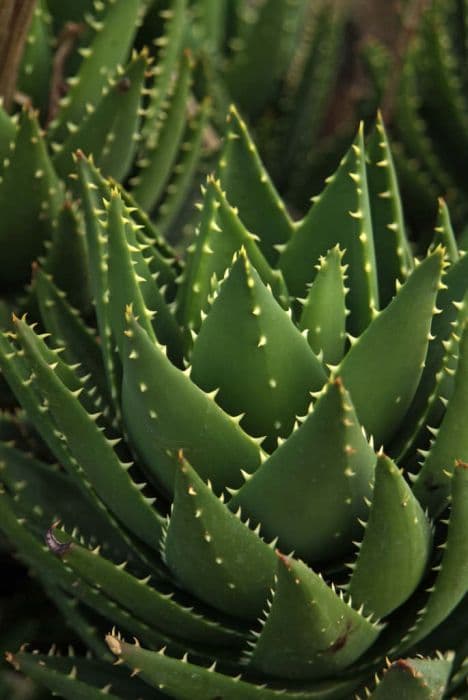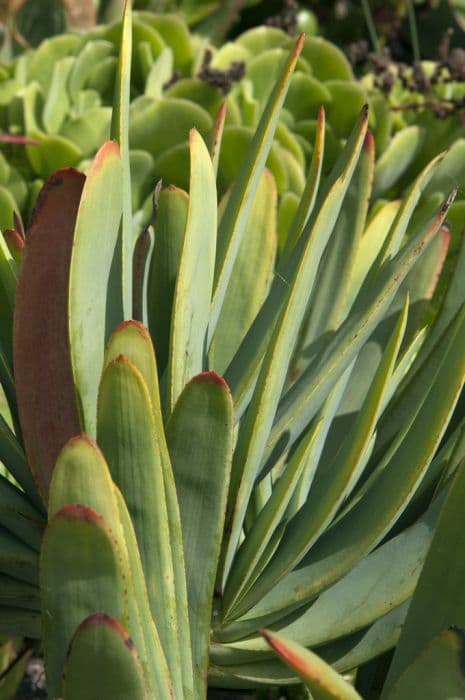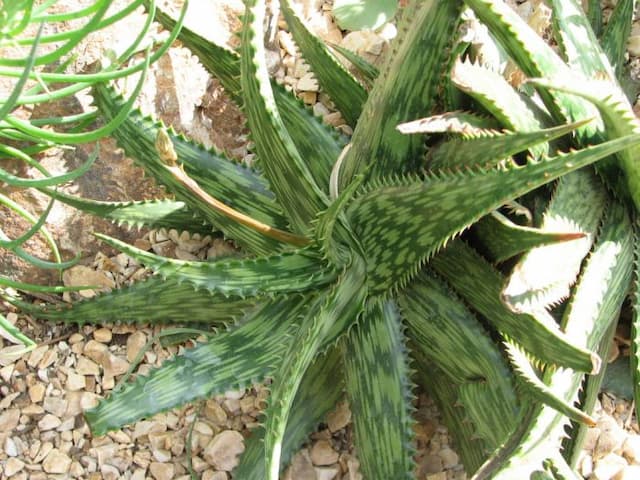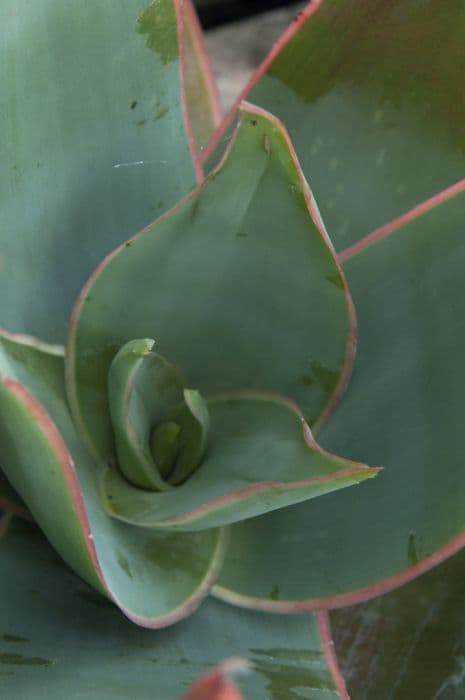Red Hot Poker Kniphofia 'Royal Standard'

ABOUT
The Kniphofia 'Royal Standard', commonly known as the Red Hot Poker or Torch Lily, is highly recognized for its distinctive and vibrant flower spikes. The plant bears a lush base of strap-like foliage, presenting in a rich, green color that forms a dense clump. The leaves are long, slender, and slightly arching, creating a grass-like effect at the base of the plant. Rising above this verdant tuft, the Torch Lily showcases its most spectacular feature—its flower spikes. Each spike is a towering, cylindrical inflorescence that sports tubular flowers. The blooms are known for their gradient coloring, which shifts from a warm, fiery red at the tip, resembling a flickering flame, to a softer hue resembling sunlight—as it moves down the spike towards the foliage. These striking colors give the plant its common names, evoking the image of a burning torch or a poker pulled from the fire. The blossoms are densely packed on the spikes and are a magnet for pollinators such as hummingbirds and bees. As the flowering season progresses, the blooms open from the bottom up, extending the period of visual interest while maintaining that characteristic fiery appearance. The contrast between the cool green of the foliage and the hot colors of the blooms creates a dramatic and bold effect in gardens and landscaping designs.
About this plant
 Names
NamesSynonyms
Red Hot Poker, Torch Lily, Tritoma
Common names
Kniphofia 'Royal Standard'.
 Toxicity
ToxicityTo humans
Red hot poker (Kniphofia 'Royal Standard') is not listed as a toxic plant to humans. However, as with many plants that are not commonly used as food, it is prudent to avoid ingesting it because individual allergies and reactions can vary, and non-food plants can sometimes cause minor irritations or gastrointestinal discomfort.
To pets
Red hot poker is generally considered non-toxic to both cats and dogs. However, if a pet were to ingest a large quantity of the plant, it might experience mild vomiting or diarrhea due to the irritant nature of the plant material, rather than a toxic reaction. Always monitor your pets and contact a vet if any unusual symptoms appear after ingestion.
 Characteristics
CharacteristicsLife cycle
Perennials
Foliage type
Evergreen
Color of leaves
Green
Flower color
Orange
Height
3 feet [0.91 meters]
Spread
2 feet [0.61 meters]
Plant type
Herb
Hardiness zones
6
Native area
Africa
Benefits
 General Benefits
General Benefits- Attracts Pollinators: Invites beneficial insects like bees and butterflies, aiding in pollination.
- Drought Tolerant: Once established, it can survive with minimal watering, making it suitable for dry climates.
- Low Maintenance: Requires little care beyond basic needs, making it ideal for gardeners of all skill levels.
- Long Blooming: Produces flowers for an extended period, providing color in the garden for many weeks.
- Architectural Interest: Adds a vertical element to garden designs with its tall flower spikes.
- Resistant to Deer: Typically not favored by deer, reducing the likelihood of damage in areas where deer are a problem.
- Seasonal Interest: Offers a distinctive look throughout the seasons, including foliage in the winter months.
- Easy to Propagate: Can be easily divided to create new plants and spread throughout the garden.
 Medical Properties
Medical PropertiesThis plant is not used for medical purposes.
 Air-purifying Qualities
Air-purifying QualitiesThis plant is not specifically known for air purifying qualities.
 Other Uses
Other Uses- Kniphofia 'Royal Standard', commonly known as Red Hot Poker, can be used to add structural interest in dried flower arrangements due to its stiff, upright habit and striking flower spikes.
- Due to their bright colors, the flowers may be used in craft work; for example, they can be incorporated into homemade paper to create a textured and colorful effect.
- The sturdy flower spikes of the Red Hot Poker can be used as a natural pest control, as they attract predatory insects that feed on garden pests.
- As a hardy plant, Kniphofia can be used for erosion control on slopes where their root systems help to stabilize soil.
- Red Hot Poker's tall flower spikes are sometimes used as bioindicators because they can reflect environmental conditions such as air quality and soil moisture through their growth vigor.
- The fibrous leaves of Kniphofia can be used in weaving to create rustic garden ornaments or small baskets.
- The robust nature of Kniphofia allows them to be used as a natural fence or border that can deter small animals due to their dense growth form.
- Red Hot Poker can serve as a teaching tool in botanical gardens or educational programs for discussions on plant adaptation and pollination strategies.
- The nectar-rich flowers are useful for producing specialty honey when used in apiculture, imparting unique flavor characteristics to the honey.
- Kniphofia's flowers can be used in natural dyeing processes to extract pigments for fabric or wool dyeing, although shades and colorfastness can vary.
Interesting Facts
 Feng Shui
Feng ShuiThe Red Hot Poker is not used in Feng Shui practice.
 Zodiac Sign Compitability
Zodiac Sign CompitabilityThe Red Hot Poker is not used in astrology practice.
 Plant Symbolism
Plant Symbolism- Standout Appearance: The bold, fiery spikes of Red Hot Poker stand out in the garden, symbolizing a desire to be noticed and a vibrant personality.
- Warmth: With its warm-hued blossoms, the plant often symbolizes warmth, comfort, and a welcoming environment.
- Passion and Energy: Its intense colors can represent intense emotions, passionate feelings, or a high level of energy.
- Attraction: The Red Hot Poker is known to attract hummingbirds and butterflies, symbolizing attraction and magnetism in human relationships.
 Water
WaterRed Hot Poker ('Royal Standard') should be watered deeply once or twice a week, providing about 1 to 1.5 inches of water each time, depending on weather conditions. During hot, dry periods, increase the watering frequency to ensure the soil remains evenly moist but not waterlogged. In cooler weather or when rainfall is abundant, reduce the amount of supplemental water provided. Always water directly at the base of the plant to minimize wetting the foliage, which can help prevent fungal diseases.
 Light
LightRed Hot Poker ('Royal Standard') thrives best in full sun, which means it should receive at least 6 to 8 hours of direct sunlight daily. Plant it in a spot where it can soak up the morning sun and continue to bask in bright light throughout the day for optimal growth and flowering.
 Temperature
TemperatureRed Hot Poker ('Royal Standard') prefers growing in temperatures ranging from 50°F to 85°F. It can tolerate temperatures as low as 0°F but may need protection from extreme cold. The ideal growing conditions for this perennial are warm days and cool nights, avoiding prolonged exposure to temperatures above 90°F.
 Pruning
PruningRed Hot Poker ('Royal Standard') should be pruned to remove spent flower stalks and encourage more blooms. Prune the foliage back in late fall or early winter, after the plant has died back, to tidy up the garden and prepare for new growth in spring. Pruning can be done every year or as necessary when the plant starts to look untidy.
 Cleaning
CleaningAs needed
 Soil
SoilRed hot poker requires well-draining soil with a pH between 6.0 and 7.0. A mix of loamy soil with additional sand or perlite and compost is best to ensure proper drainage and fertility.
 Repotting
RepottingRed hot poker is typically not repotted often, as it is a hardy perennial. Repotting may be done every 3-5 years to refresh the soil or to divide the plants if they become too crowded.
 Humidity & Misting
Humidity & MistingRed hot poker prefers moderate humidity levels but is quite adaptable and can tolerate the varying humidity conditions of most temperate climates without issue.
 Suitable locations
Suitable locationsIndoor
Provide bright light and keep soil moderately dry.
Outdoor
Full sun, well-draining soil, protect from extreme cold.
Hardiness zone
5-9 USDA
 Life cycle
Life cycleThe Torch Lily, also known as Kniphofia 'Royal Standard', begins its life cycle as a seed, which germinates in moist soil under warm conditions. After germination, the seedling grows to form a rosette of strap-like leaves, and in its first year, it focuses on establishing a strong root system. As a perennial, it enters a period of vegetative growth each spring, where the foliage expands and the plant gains energy for flowering. Once mature, typically in its second year, it sends up a tall flowering stalk in the summer, bearing the distinctive fiery-hued spike of tubular flowers that attract pollinators. After pollination, seeds form and are eventually dispersed to repeat the cycle, while the plant itself goes dormant in winter, conserving energy for the following season. Depending on growing conditions and care, the Torch Lily can live for several years, with proper division and care extending its vitality.
 Propogation
PropogationPropogation time
Spring-Early Summer
The most popular method of propagating the Red Hot Poker, or Kniphofia 'Royal Standard', is by division. The best time to propagate is in the spring when the plants are coming out of dormancy and you can more easily see the growth of new shoots. To divide, carefully dig up an established clump and gently separate it into smaller sections, making sure that each section has at least one growing point or shoot. Replant the divisions immediately at the same depth they were growing at before, spacing them about 18 inches (approximately 45 centimeters) apart to allow for growth. Water the newly planted divisions well to help establish them. This method is effective since it not only helps to rejuvenate older clumps that might be losing vigor, but also allows gardeners to quickly increase the number of plants in their garden.









